Discover 50 hidden attractions, cool sights, and unusual things to do in Iran. Don't miss out on these must-see attractions: Chehel Sotoun (Isfahan), Golestan Palace (Tehran) or Jameh Mosque of Isfahan (Isfahan).
Below, you can find the list of the most amazing places you should visit in Iran.
Table of Contents
Chehel Sotoun, Isfahan
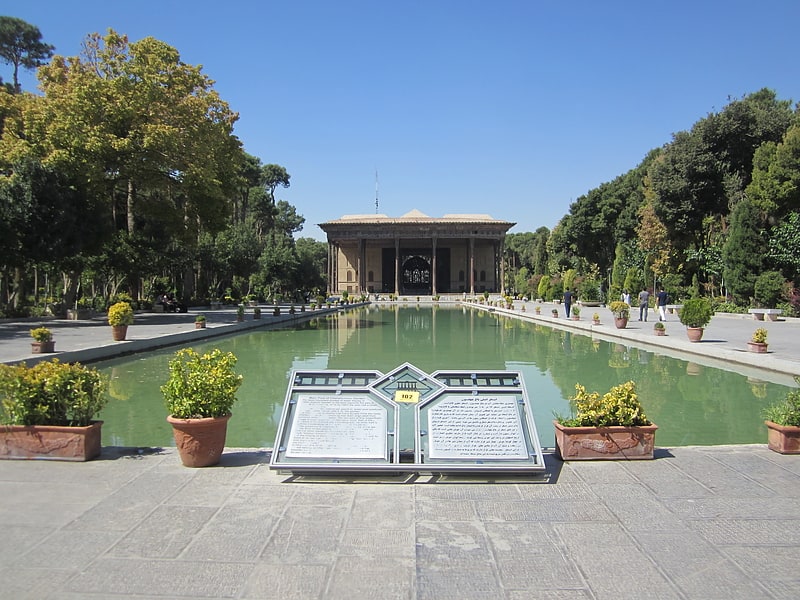
Also known as: چهلستون
Elegant, 17th-c. royal pavilion and garden. Chehel Sotoun is a Persian pavilion in the middle of a park at the far end of a long pool, in Isfahan, Iran, built by Shah Abbas II to be used for his entertainment and receptions. In this palace, Shah Abbas II and his successors would receive dignitaries and ambassadors, either on the terrace or in one of the stately reception halls.
The name, meaning "Forty Columns" in Persian, was inspired by the twenty slender wooden columns supporting the entrance pavilion, which, when reflected in the waters of the fountain, is said to appear to be forty.
As with Ali Qapu, the palace contains many frescoes and paintings on ceramic. Many of the ceramic panels have been dispersed and are now in the possession of major museums in the west. They depict specific historical scenes such as the infamous Battle of Chaldiran against the Ottoman Sultan Selim I, the reception of an Uzbek King in 1646, when the palace had just been completed; the welcome extended to the Mughal Emperor, Humayun who took refuge in Iran in 1544; the battle of Taher-Abad in 1510 where the Safavid Shah Ismail I vanquished and killed the Uzbek King. A more recent painting depicts Nader Shah's victory against the Indian Army at Karnal in 1739. There are also less historical, but even more aesthetic compositions in the traditional miniature style which celebrate the joy of life and love.
The Chehel Sotoun Palace is among the 9 Iranian Gardens which are collectively registered as one of the Iran’s 23 registered World Heritage Sites under the name of the Persian Garden.[1]
Address: Imam Hossein Square, Isfahan
Golestan Palace, Tehran
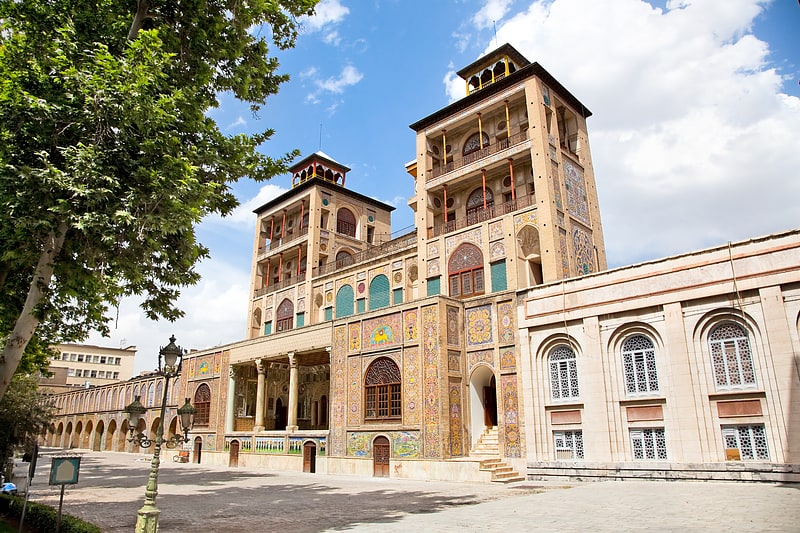
Also known as: کاخ گلستان
16th century palace and museum in citadel. The Golestan Palace, also known as the Gulistan Palace and sometimes known as the Rose Garden Palace, is the former royal Qajar complex in Iran's capital city, Tehran.
One of the oldest historic monuments in the city of Tehran, and of world heritage status, the Golestan Palace belongs to a group of royal buildings that were once enclosed within the mud-thatched walls of Tehran's arg ("citadel"). It consists of gardens, royal buildings, and collections of Iranian crafts and European presents from the 18th and 19th centuries.[2]
Address: Arq Suquare, 11369 Tehran
Jameh Mosque of Isfahan, Isfahan
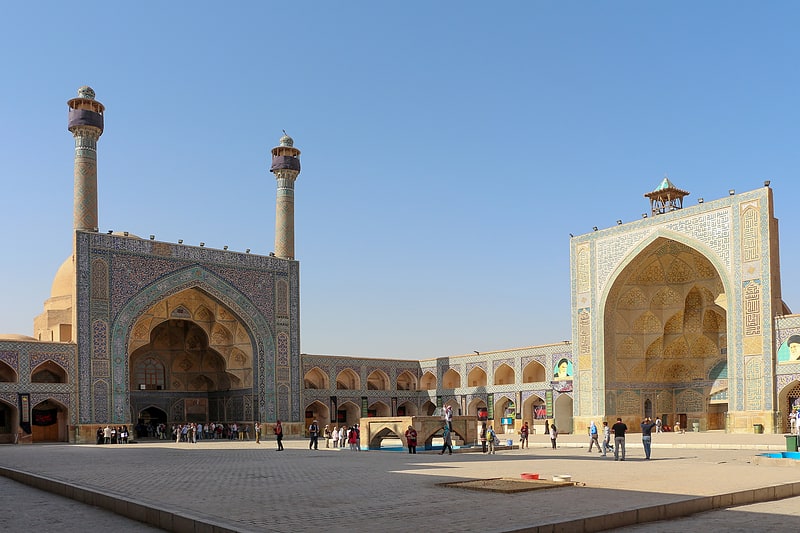
Also known as: مسجد جامع اصفهان
Mosque known for its varied architecture. The Jāmeh Mosque of Isfahān or Jāme' Mosque of Isfahān, also known as the Atiq Mosque and the Friday Mosque of Isfahān, is a historic congregational mosque of Isfahan, Iran. The mosque is the result of continual construction, reconstruction, additions and renovations on the site from around 771 to the end of the 20th century. The Grand Bazaar of Isfahan can be found towards the southwest wing of the mosque. It has been a UNESCO World Heritage Site since 2012. It is one of the largest and most important monuments of Islamic architecture in Iran.[3]
Address: Esfahan Bazaar, 81464 Isfahan
Azerbaijan Museum, Tabriz
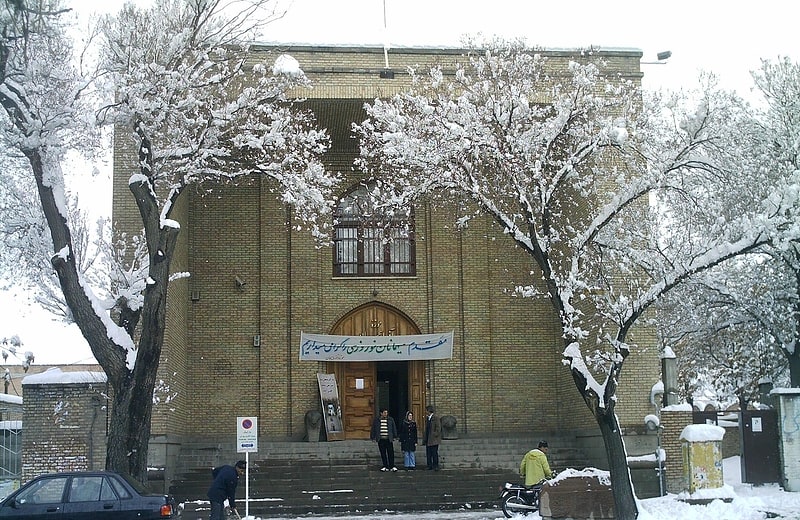
Also known as: موزه آذربایجان
Museum in Tabriz, Iran. Azerbaijan Museum is the major archaeological and historical museum in Tabriz, in the northwest part of Iran. It was established on April 1958. The museum consists of three major halls, a side yard, office rooms and a library. It mostly contains objects discovered from excavations in Iranian Azerbaijan, also some artworks and sculptures of artists. Its library contains more than 2500 books, both handwritten and printed, about history, archaeology, art and Iranian culture. Apart from National Museum of Iran in Tehran, Azerbaijan Museum has the largest collection belonging to different periods of Iran's history.[4]
Address: مصلای بزرگ تبریز, Tabriz
Shams-ol-Emareh, Tehran
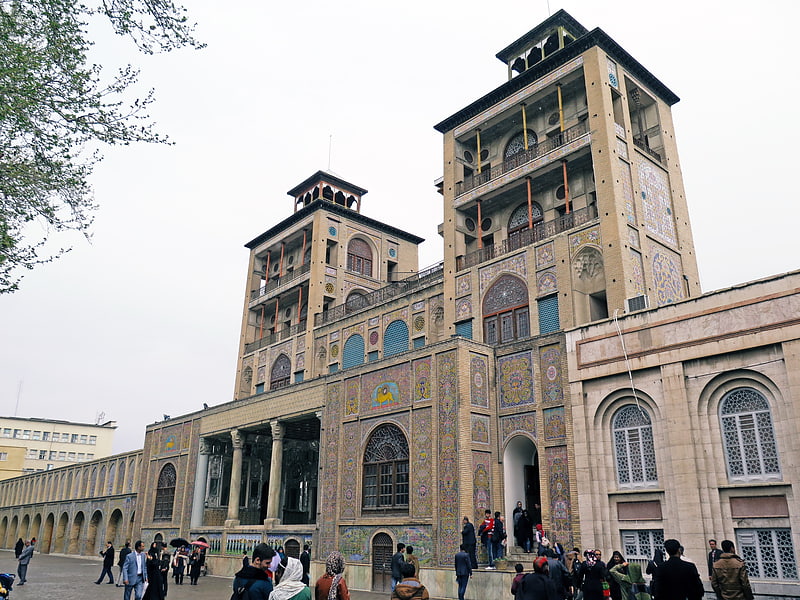
Building in Tehran, Iran. Shams-ol-Emareh is one of Tehran’s historical buildings and a remnant of Qajar Dynasty. It is one of the most prominent buildings on the east side of Golestan Palace. It was built around 1830. It is notable for its height, decorations and design.
Shams-ol-Emareh is 35 meters tall with five floors. It was the tallest building in Tehran when it was built, and the first building using metal in its structure. All the pillars in the upper floors are of cast iron. Shams-ol-Emareh was the symbol of Tehran before Sar dar Baghe Melli was built.[5]
Ālī Qāpū, Isfahan
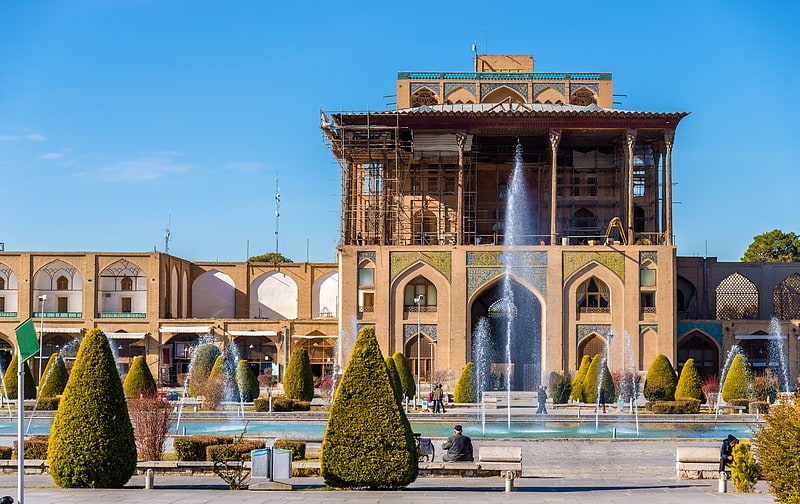
Also known as: عالیقاپو
Majestic palace with a lavish music room. Ali Qapu Palace or the Grand Ālī Qāpū is an imperial palace in Isfahan, Iran. It is located on the western side of the Naqsh-e Jahan Square, opposite to Sheikh Lotfollah Mosque, and had been originally designed as a vast portal entrance to the grand palace which stretched from the Naqsh-e Jahan Square to the Chahar Baq Boulevard. The palace served as the official residence of Persian Emperors of the Safavid dynasty. UNESCO inscribed the Palace and the Square as a World Heritage Site due to its cultural and historical importance. The palace is forty-eight meters high and there are six floors, each accessible by a difficult spiral staircase. In the sixth floor, Music Hall, deep circular niches are found in the walls, having not only aesthetic value, but also acoustic. Ālī Qāpū is regarded as the best example of Safavid architecture and a symbol of Iran's Islamic heritage.
The name Ali Qapu, from Persian ‘Ālī (meaning "imperial" or "great"), and Azerbaijani Qāpū (meaning "gate"), was given to this place as it was right at the entrance to the Safavid palaces which stretched from the Naqsh-e Jahan Square to the Chahar Baq Boulevard. The building, another wonderful Safavid edifice, was built by decree of Shah Abbas I in the early seventeenth century. It was here that the great monarch used to entertain noble visitors, and foreign ambassadors. Shah Abbas, here for the first time, celebrated the Nowruz (Iranian New Year) of 1006 AH / 1597 C.E.
Ali Qapu is rich in naturalistic wall paintings by Reza Abbasi, the court painter of Shah Abbas I, and his pupils. There are floral, animal, and bird motifs in his works. The highly ornamented doors and windows of the palace have almost all been pillaged at times of social anarchy. Only one window on the third floor has escaped the ravages of time. Ali Qapu was repaired and restored substantially during the reign of Shah Sultan Hussein, the last Safavid ruler, but fell into a dreadful state of dilapidation again during the short reign of invading Afghans. Under the reign of Naser ad-Din Shah the Qajar (1848–96), the Safavid cornices and floral tiles above the portal were replaced by tiles bearing inscriptions.
Shah Abbas II was enthusiastic about the embellishment and perfection of Ali Qapu. His chief contribution was given to the magnificent hall, the constructors on the third floor. The 18 columns of the hall are covered with mirrors and its ceiling is decorated with great paintings.
The chancellery was stationed on the first floor. On the sixth, the royal reception and banquets were held. The largest rooms are found on this floor. The stucco decoration of the banquet hall abounds in motif of various vessels and cups. The sixth floor was popularly called the Music Hall. Here various ensembles performed music and sang songs.
From the upper galleries, the Safavid ruler watched Chowgan (polo), army maneuvers and horse-racing in the Naqsh-e Jahan square.
The palace is depicted on the reverse of the Iranian 20,000 rials banknote. The palace is also depicted on the reverse of the Iranian 20 rials 1953 banknote series.[6]
Address: Naghshe Jahan Sq,Sepah St, Imam Hossein Square, 4 Bagh St, Isfahan, Iran, 81464 Isfahan
Eram Garden, Shiraz

Also known as: باغ ارم
Paved, manicured gardens with palm trees. Eram Garden is a historic Persian garden in Shiraz, Iran. The garden, and the building within it, are located at the northern shore of the Khoshk River in the Fars province.[7]
Address: Eram St, Shiraz
Blue Mosque, Tabriz
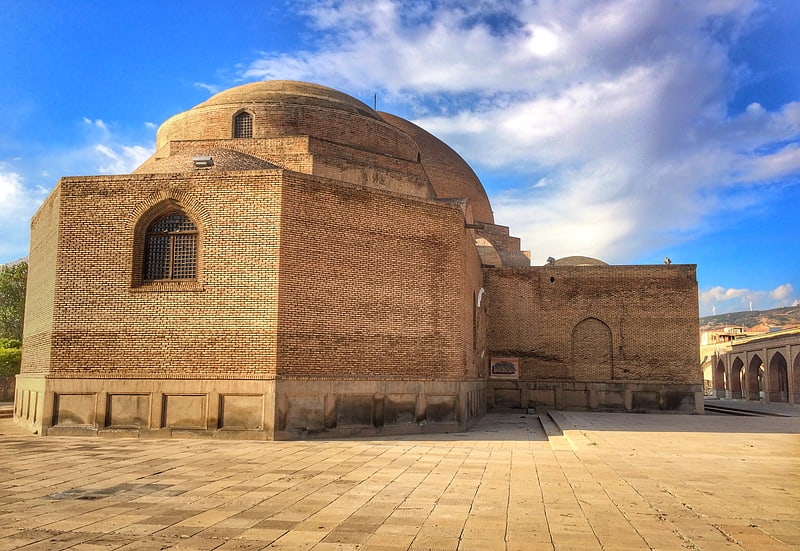
Also known as: مسجد کبود
15th-century mosque with ornate mosaics. The Blue Mosque is a historic mosque in Tabriz, Iran. The mosque and some other public buildings were constructed in 1465 upon the order of Jahan Shah, the ruler of Kara Koyunlu.
The mosque was severely damaged in an earthquake in 1780, leaving only the iwan (entrance hall). Reconstruction began in 1973 by Reza Memaran Benam under the supervision of Iranian Ministry of Culture. However, it is still incomplete.[8]
Address: Imam Khomeyni, Tabriz
Azadi Tower, Tehran

Also known as: برج آزادی
Tower with museum and observation deck. The Azadi Tower, formerly known as the Shahyad Tower, is a monument located on Azadi Square in Tehran, Iran. It is one of the landmarks of Tehran, marking the west entrance to the city, and is part of the Azadi Cultural Complex, which also includes an underground museum.
The tower is about 45 metres (148 ft) tall and is completely clad in cut marble. It was commissioned by Mohammad Reza Pahlavi, the last Shah of Iran, to mark the 2,500-year celebration of the Persian Empire and completed in 1971.
After winning a competition, architect Hossein Amanat was tasked to design the tower. His ideas were based upon classical and post-classical Iranian architecture, popular influences on art in the 1960s following the White Revolution. Iran's increasing wealth sparked modernization programs and sent the art industry into a renaissance-like period.[9]
Address: Azadi Square, 11369 Tehran
Bazaar of Tabriz, Tabriz

Also known as: بازار تبریز
Shopping center in Tabriz, Iran. The Bazaar of Tabriz is a historical market situated in the city center of Tabriz, Iran. It is one of the oldest bazaars in the Middle East and the largest covered bazaar in the world. It is one of Iran's UNESCO World Heritage Sites.[10]
Fin Garden, Kashan

Also known as: باغ فین
Tourist attraction in Kashan, Iran. Fin Garden located in Kashan, Iran, is a historical Persian garden. It contains Kashan's Fin Bath, where Amir Kabir, the Qajarid chancellor, was murdered by an assassin sent by King Nasereddin Shah in 1852. Completed in 1590, the Fin Garden is the oldest extant garden in Iran.[11]
Address: Amir Kabir Street, 87134 Kashan
Tomb of Hafez, Shiraz
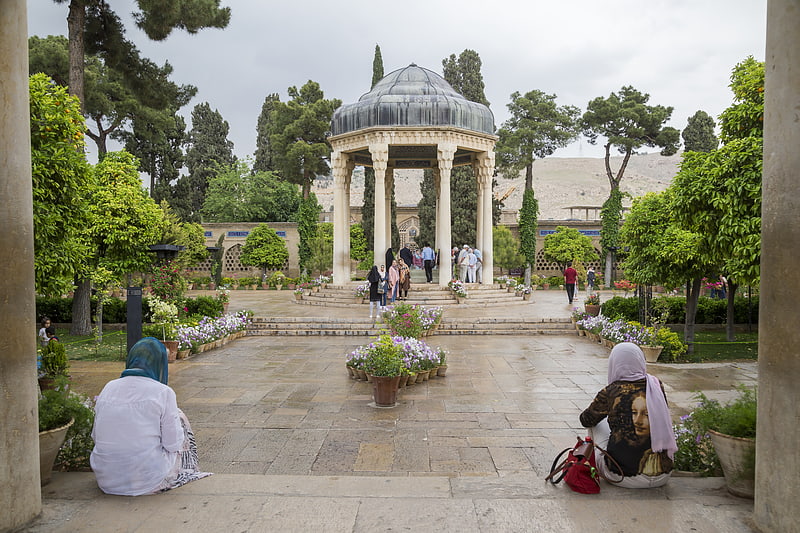
Also known as: حافظیه
Iconic poet's tomb and memorial hall. The Tomb of Hafez, commonly known as Hāfezieh, are two memorial structures erected in the northern edge of Shiraz, Iran, in memory of the celebrated Persian poet Hafez. The open pavilion structures are situated in the Musalla Gardens on the north bank of a seasonal river and house the marble tomb of Hafez. The present buildings, built in 1935 and designed by the French architect and archaeologist André Godard, are at the site of previous structures, the best-known of which was built in 1773. The tomb, its gardens, and the surrounding memorials to other great figures are a focus of tourism in Shiraz.[12]
Address: Hafeziye Street, 71364 Shiraz
Vakil Bazaar, Shiraz
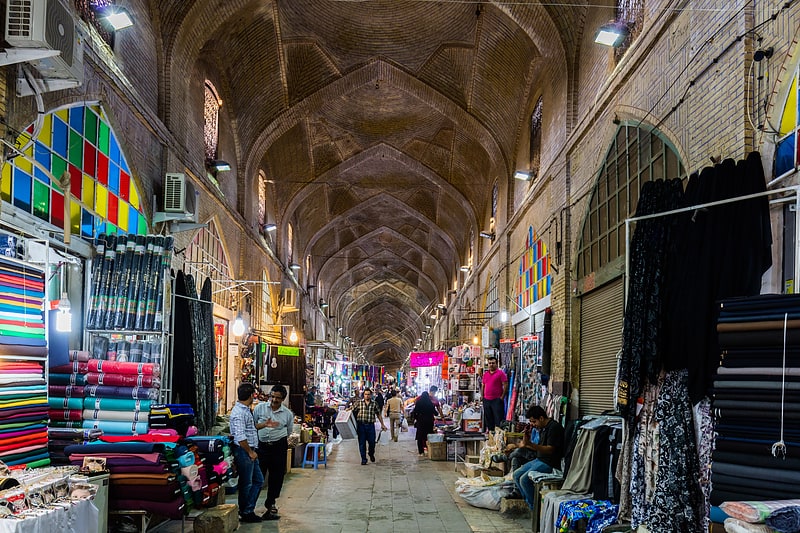
Also known as: بازار وکیل
Historical marketplace for various goods. Vakil Bazaar is the main bazaar of Shiraz, Iran, located in the historical center of the city.
It is thought that the market originally was established by the Buwayhids in the 11th century AD, and was completed mainly by the Atabaks of Fars, and was renamed after Karim Khan Zand only in the 18th century.
The bazaar has beautiful courtyards, caravansarais, bath houses, and old shops which are deemed among the best places in Shiraz to buy Persian rugs, spices, copper handicrafts and antiques.
Like other Middle Eastern bazaars, there are a few mosques and Imamzadehs constructed beside or behind the bazaar.[13]
Imam Reza Shrine, Mashhad

Also known as: حرم امام رضا
Mosque in Mashhad, Iran. The Imam Reza shrine in Mashhad, Iran, is a complex which contains the mausoleum of Imam Reza, the eighth Imam of Twelver Shias. It is the largest mosque in the world by area. Also contained within the complex are the Goharshad Mosque, a museum, a library, four seminaries, a cemetery, the Razavi University of Islamic Sciences, a dining hall for pilgrims, vast prayer halls, and other buildings.
The complex is a tourism center in Iran and has been described as "the heart of the Shia Iran" with 25 million Iranian and non-Iranian Shias visiting the shrine each year, according to a 2007 estimate. The complex is managed by Astan Quds Razavi Foundation and currently headed by Ahmad Marvi, a prominent Iranian cleric.
The shrine itself covers an area of 267,079 square metres (2,874,810 sq ft) while the seven courtyards which surround it cover an area of 331,578 square metres (3,569,080 sq ft), totaling 598,657 m2 (6,443,890 sq ft). Every year the ceremony of Dust Clearing is celebrated in the Imam Reza shrine.[14]
Address: Aab Sq., Mashhad
Sultan Amir Ahmad Bathhouse, Kashan
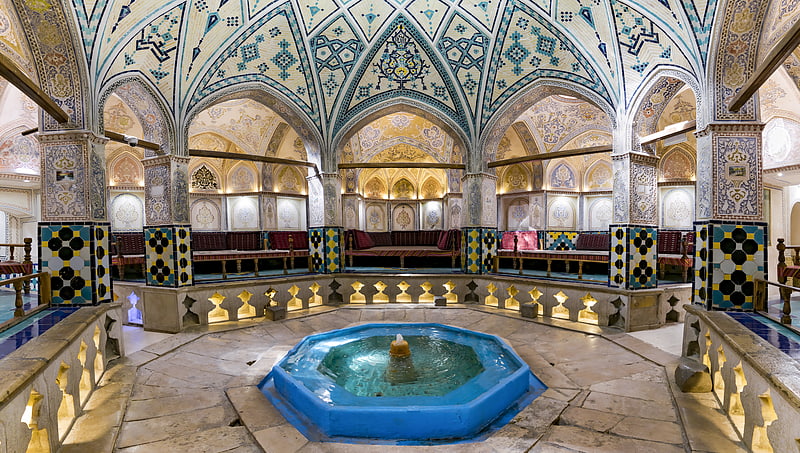
Also known as: حمام سلطان امیر احمد
Tourist attraction in Kashan, Iran. Sultan Amir Ahmad Bathhouse, also known as the Qasemi Bathhouse, is a traditional Iranian public bathhouse in Kashan, Iran. It was constructed in the 16th century, during the Safavid era; however, the bathhouse was damaged in 1778 as a result of an earthquake and was renovated during the Qajar era. The bathhouse is named after Imamzadeh Sultan Amir Ahmad, whose mausoleum is nearby.
Sultan Amir Ahmad Bathhouse, with an area of around 1000 square meters, consists of two main parts: the sarbineh (dressing hall) and garmkhaneh (hot bathing hall). The sarbineh is a large octagonal hall and has an octagonal pool in the middle, separated by 8 pillars from the outer section. There are four pillars in the garmkhaneh, which make smaller bathing rooms all around as well as the entrance section to the khazineh (final bathing room) in the middle. The interior of the bathhouse is decorated with turquoise and gold tilework, plasterwork, brickwork, as well as artistic paintings. The roof of the bathhouse is made of multiple domes that contain convex glasses to provide sufficient lighting to the bathhouse while concealing it from the outside.[15]
Tabatabai House, Kashan
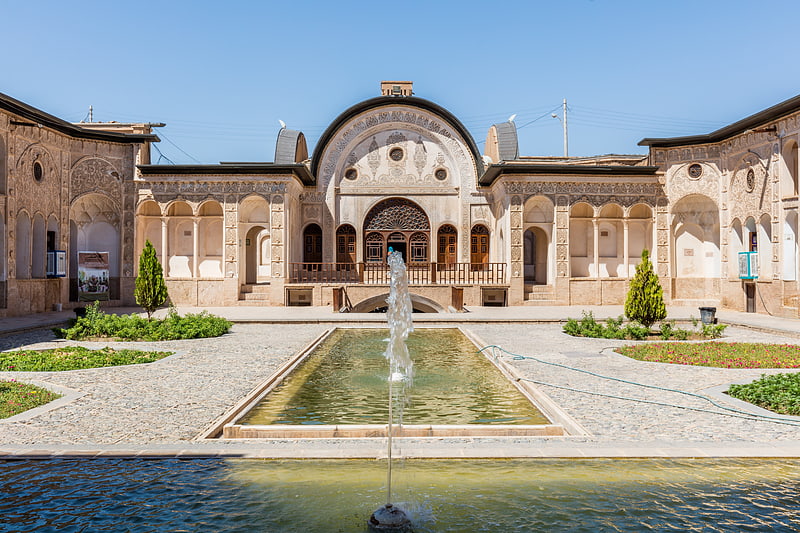
Also known as: خانه طباطباییها
Tourist attraction in Kashan, Iran. The Tabatabai House is a historic house museum in Kashan, Iran. It was built around 1880, during the reign of the Qajar dynasty, for the affluent Tabātabāei family. It is one of the prominent historic houses of Kashan and Iran, together with the Āmeri House, the Borujerdi House, and others.[16]
Naqsh-e Rustam, Persepolis
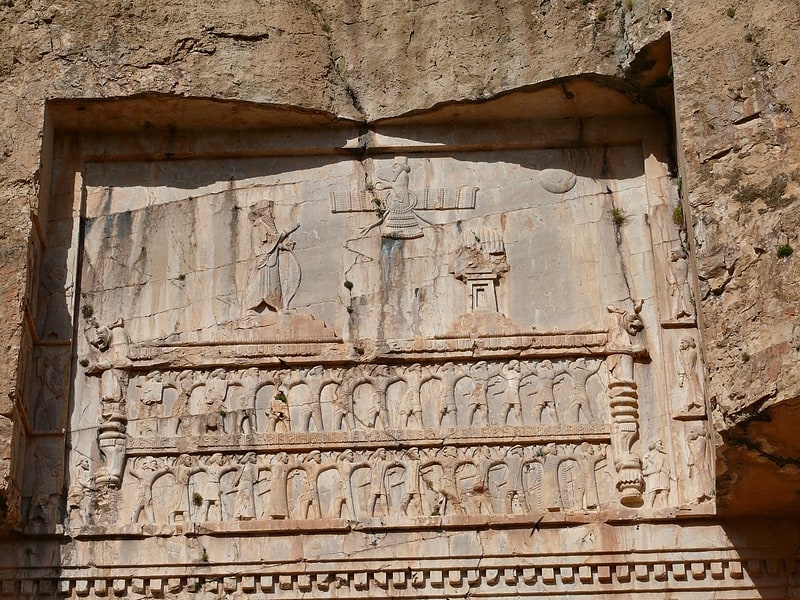
Also known as: نقش رستم
Necropolis. Naqsh-e Rostam is an ancient archeological site and necropolis located about 12 km northwest of Persepolis, in Fars Province, Iran. A collection of ancient Iranian rock reliefs are cut into the face of the mountain and the mountain contains the final resting place of four Achaemenid kings notably king Darius the Great and his son, Xerxes. This site is of great significance to the history of Iran and to Iranians, as it contains various archeological sites carved into the rock wall through time for more than a millennium from the Elamites and Achaemenids to Sassanians. It lies a few hundred meters from Naqsh-e Rajab, with a further four Sassanid rock reliefs, three celebrating kings and one a high priest.
Naqsh-e Rostam is the necropolis of the Achaemenid dynasty (c. 550–330 BC), with four large tombs cut high into the cliff face. These have mainly architectural decoration, but the facades include large panels over the doorways, each very similar in content, with figures of the king being invested by a god, above a zone with rows of smaller figures bearing tribute, with soldiers and officials. The three classes of figures are sharply differentiated in size. The entrance to each tomb is at the center of each cross, which opens onto a small chamber, where the king lay in a sarcophagus.
Well below the Achaemenid tombs, near ground level, are rock reliefs with large figures of Sassanian kings, some meeting gods, others in combat. The most famous shows the Sassanian king Shapur I on horseback, with the Roman Emperor Valerian bowing to him in submission, and Philip the Arab (an earlier emperor who paid Shapur tribute) holding Shapur's horse, while the dead Emperor Gordian III, killed in battle, lies beneath it (other identifications have been suggested). This commemorates the Battle of Edessa in 260 AD, when Valerian became the only Roman Emperor who was captured as a prisoner of war, a lasting humiliation for the Romans. The placing of these reliefs clearly suggests the Sassanid intention to link themselves with the glories of the earlier Achaemenid Empire.[17]
Address: Vicino a Persepolis, 73714 Marvdasht
Amir Chakhmaq Complex, Yazd
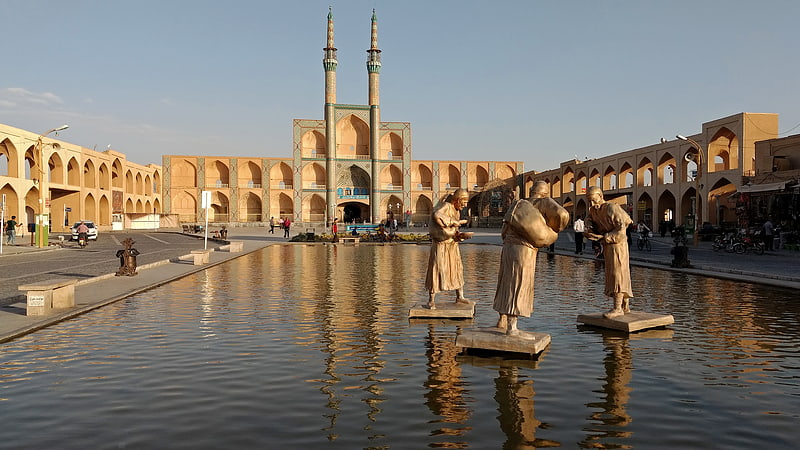
Also known as: مجموعه میدان امیرچخماق
Historical landmark in Yazd, Iran. The Amir Chakhmaq Complex is a prominent structure in Yazd, Iran, noted for its symmetrical sunken alcoves. It is a mosque located on a square of the same name. It also contains a caravanserai, a tekyeh, a bathhouse, a cold water well, and a confectionery. At night, the building is lit up after twilight hours after sun set with orange lighting in the arched alcoves which makes it a spectacle. During the Iran–Iraq War and the Iraq wars with the United States and Afghanistan, many Iraqis and Afghanis came to inhabit the Amir Chakhmaq Square.[18]
Tachara, Persepolis
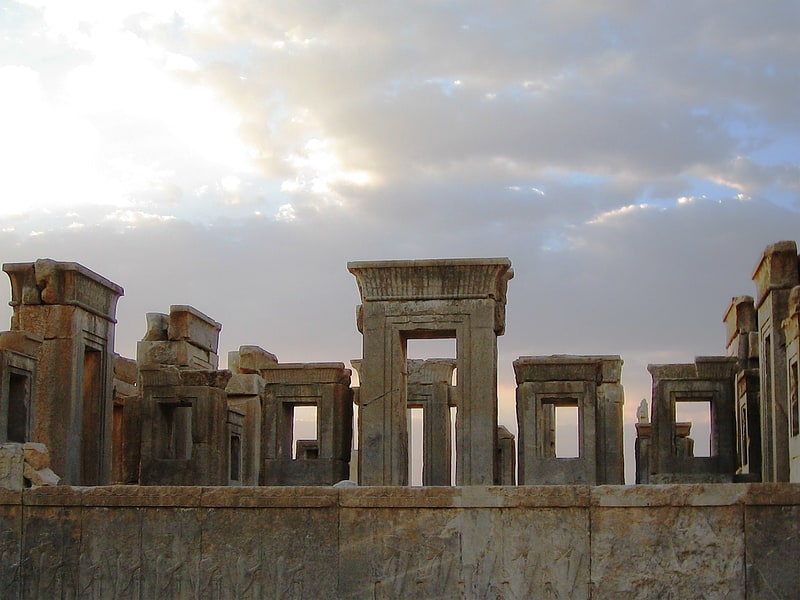
Also known as: کاخ تچر
The Tachara, or the Tachar Château, also referred to as the Palace of Darius the Great, was the exclusive building of Darius I at Persepolis, Iran. It is located 70 km northeast of the modern city of Shiraz in Fars Province.[19]
Tomb of Khajeh Rabie, Mashhad

Tomb in Mashhad, Iran. The Tomb of Khajeh Rabie dates back to the Safavid dynasty and is located in Mashhad, at the end of Khajeh Rabie Street.[20]
Goharshad Mosque, Mashhad
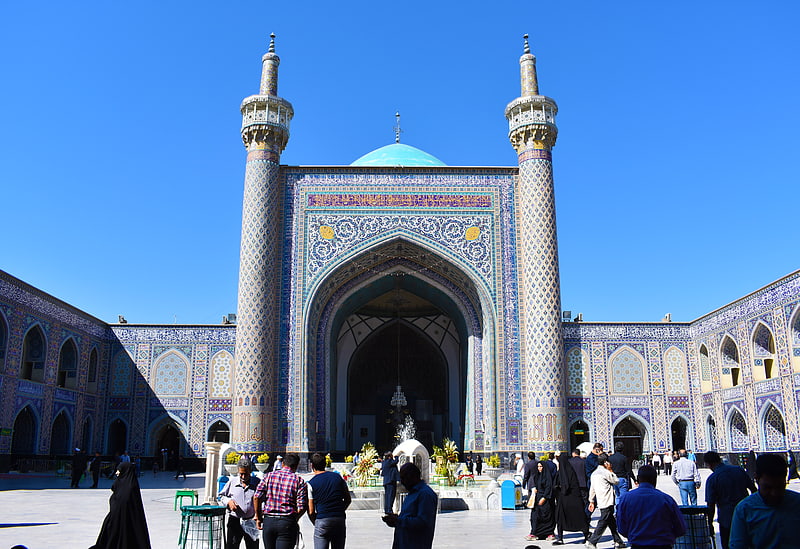
Also known as: مسجد گوهرشاد
15th-century mosque with vibrant designs. Goharshad Mosque is a grand congregational mosque built during the Timurid period in Mashhad, Razavi Khorasan Province, Iran, which now serves as one of the prayer halls within the Imam Reza shrine complex.[21]
Jameh Mosque of Nain, Yazd
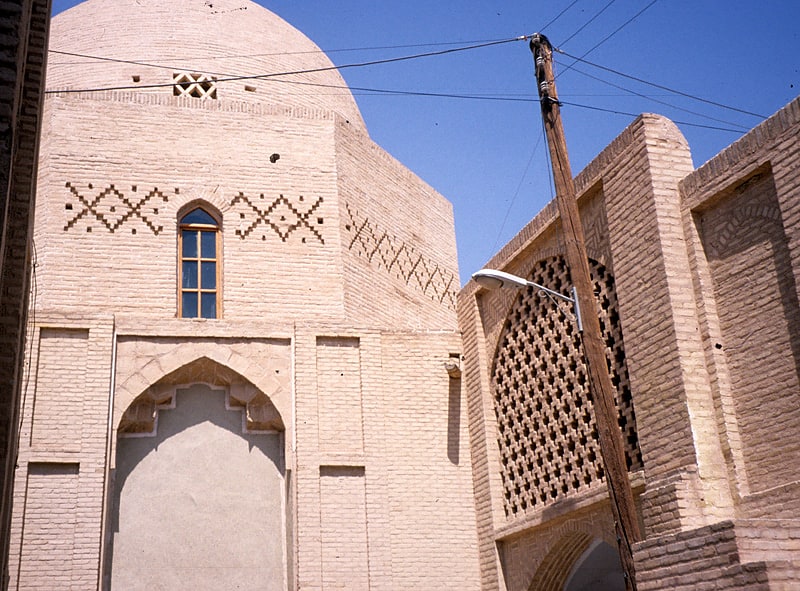
Also known as: مسجد جامع نائین
Mosque. The Jāmeh Mosque of Nā'īn is the grand, congregational mosque of Nā'īn city, within Isfahān Province of Iran. Although the mosque is one of the oldest in Iran, it is still in use and is protected by Iran's Cultural Heritage Organization.
This mosque is perhaps one of the oldest mosques in Iran, and despite being built hundreds of years ago it still preserves its original architecture. French professor, Arthurp Pops believed that the mosque foundation goes back to 9th century. It has a very simple plan but is still very beautiful. The mosque contains a central rectangular courtyard that is surrounded with hypostyles on three sides. At one of these hypostyles the mihrab of the mosque is located. The mihrab at Islamic mosque is a niche at wall that shows the direction of "Qebleh" that is the direction of Mecca the holy city that Muslims prays towards it five times daily. This mihrab has an amazingly beautiful stucco work decoration, created probably during the 9th or 10th century. Also right beside it, there as an altar made of wood with delicate wooden inlay work. The Mosque also has a 28-meter-high minaret belonging to the Seljuk era,10th century.[22]
Jameh Mosque of Yazd, Yazd
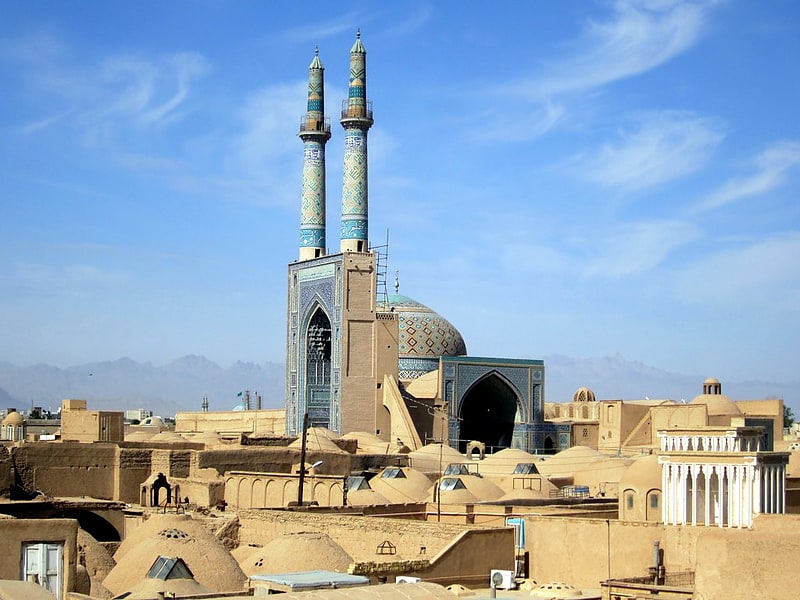
Also known as: مسجد جامع یزد
14th-century Azeri-style mosque. The Jāmeh Mosque of Yazd is the grand, congregational mosque of Yazd city, within the Yazd Province of Iran. The mosque is depicted on the obverse of the Iranian 200 rials banknote.[23]
Apadana, Persepolis

Also known as: آپادانا
Building in Takht-e Jamshid, Iran. Apadana is a large hypostyle hall in Persepolis, Iran. It belongs to the oldest building phase of the city of Persepolis, in the first half of the 6th century BC, as part of the original design by Darius the Great. Its construction was completed by Xerxes I. Modern scholarship "demonstrates the metaphorical nature of the Apadana reliefs as idealised social orders".[24]
Address: Takht-e Jamshid Blvd., Persepolis
Taq Bostan, Kermanshah
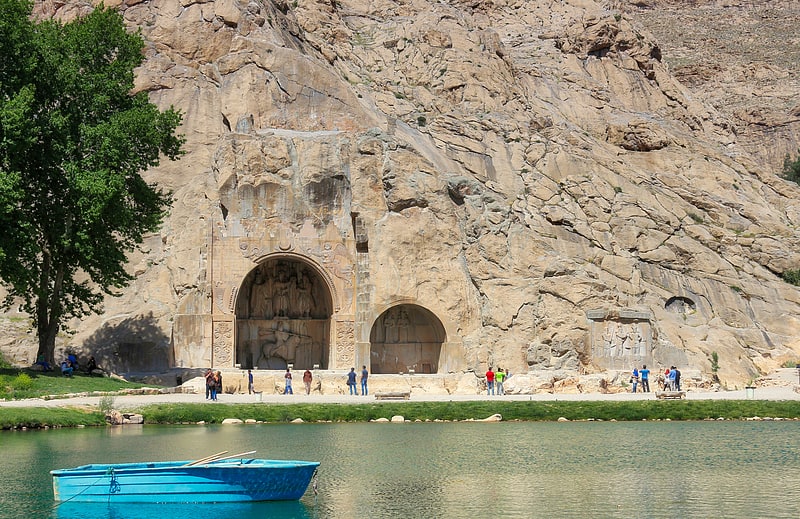
Also known as: طاق بستان
Historical landmark in Kermanshah, Iran. Taq-e Bostan is a site with a series of large rock reliefs from the era of the Sassanid Empire of Persia, carved around the 4th century CE.
This example of Persian Sassanid art is located 5 km from the city center of Kermanshah. It is located in the heart of the Zagros mountains, where it has endured almost 1,700 years of wind and rain. Originally, several sources were visible next to and below the reliefs and arches, some of which are now covered. Sources next to the reliefs still feed a large basin in front of the rock. The site has been turned into an archaeological park and a series of late Sassanian and Islamic column capitals have been brought together (some found at Taq Bostan, others at Mount Behistun and Kermanshah).
The carvings, some of the finest and best-preserved examples of Persian sculpture under the Sassanids, include representations of the investitures of Ardashir II (379–383) and Shapur III (383–388). Like other Sassanid symbols, Taq-e Bostan, and its relief patterns accentuate power, religious tendencies, glory, honor, the vastness of the court, game and fighting spirit, festivity, joy, and rejoicing.
Sassanid kings chose a beautiful setting for their rock reliefs along an historic Silk Road caravan route waypoint and campground. The reliefs are adjacent to sacred springs that empty into a large reflecting pool at the base of a mountain cliff.
Taq-e Bostan and its rock relief are one of the 30 surviving Sassanid relics of the Zagros mountains. According to Arthur Pope, the founder of the Iranian Art and Archeology Institute in the United States of America, "art was characteristic of the Iranian people and the gift which they endowed the world with."[25]
Avicenna Mausoleum, Hamadan

Also known as: آرامگاه بوعلیسینا
Museum in Hamadan, Iran. The Mausoleum of Avicenna is a monumental complex located at Avicenna Square, Hamadan, Iran.
Dedicated to the Iranian polymath Avicenna, the complex includes a library, a small museum, and a spindle-shaped tower inspired by the Ziyarid-era Kavus Tower.[26]
Address: Buali Sina Sq., Hamadan
Greek Ship, Kish Island
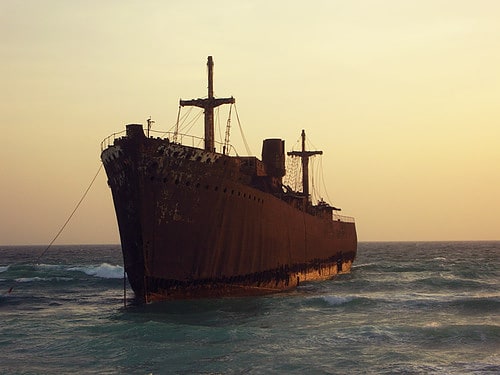
Also known as: کشتی یونانی
Ship. The Greek Ship is the nickname of a cargo steamship, Khoula F, that has been beached on the southwest coast of Kish Island, Iran, since 1966. She was built in 1943 by the British shipyard of William Hamilton and Company in Port Glasgow, Scotland, under the name Empire Trumpet. From 1946 to 1966, she passed through a series of British and Iranian owners and various changes of name. Her final owners were Greek, and the nickname given to her derives from them.[27]
Jameh Mosque of Kerman, Kerman
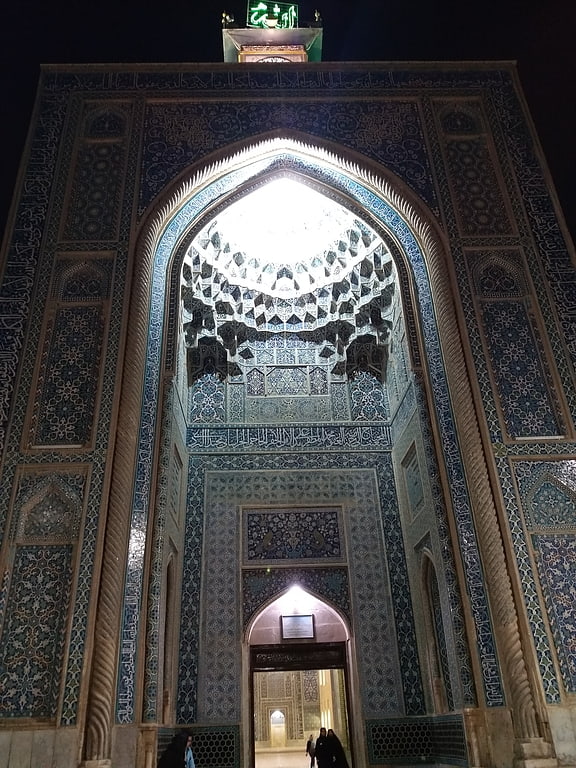
Jameh Mosque of Kerman is a mosque located in Kerman, Iran. The mosque was built at the time of Mubariz al-Din Muhammad, Muzaffarids, in the 14th century. The western side of the building features a high portal which has been decorated with decorative tile-works and a watch tower.[28]
Tomb of Esther and Mordechai, Hamadan

Also known as: آرامگاه استر و مردخای
Tomb in Hamadan, Iran. The Tomb of Esther and Mordechai is a tomb located in Hamadan, Iran. Iranian Jews believe it houses the remains of the biblical Queen Esther and her uncle Mordechai, and it is the most important pilgrimage site for Jews in Iran. There is no mention of it in either the Bavli or the Jerusalem Talmud and the Iranian Jewish tradition has not been supported by Jews beyond Iran.[29]
Vakil Caravanserai, Kerman
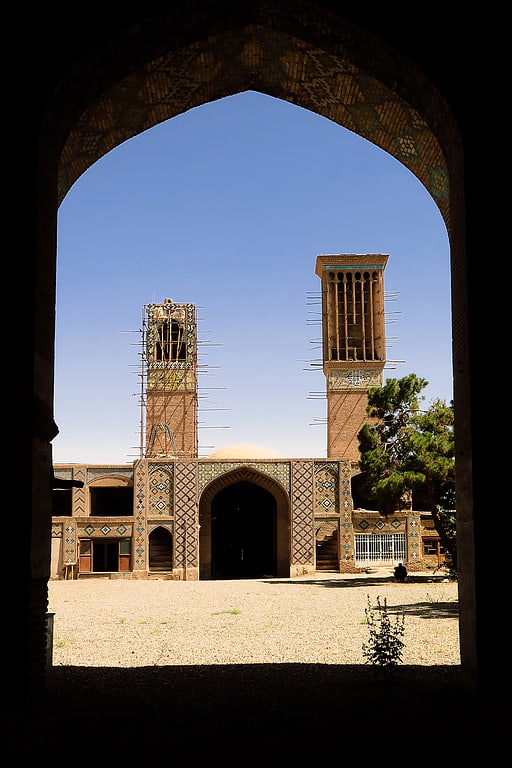
Vakil Caravanserai is located in the southern Iranian city of Kerman. It is one of the largest Caravanserais in the world. Old Iran had many Caravanserais for long distance travelers to rest. Vakil Caravanserai has 120 rooms in two floors. It was built around 1870 by the order of Mohammad Ismail Khan, the time governor of Kerman. The whole building was completed around 1870. This is one of the caravanserais which exist in Kerman.[30]
Jameh Mosque of Hamadan, Hamadan

Jameh Mosque of Hamadan in Hamadan, built during the Qajar dynasty.[31]
Sheikhan cemetery, Qom
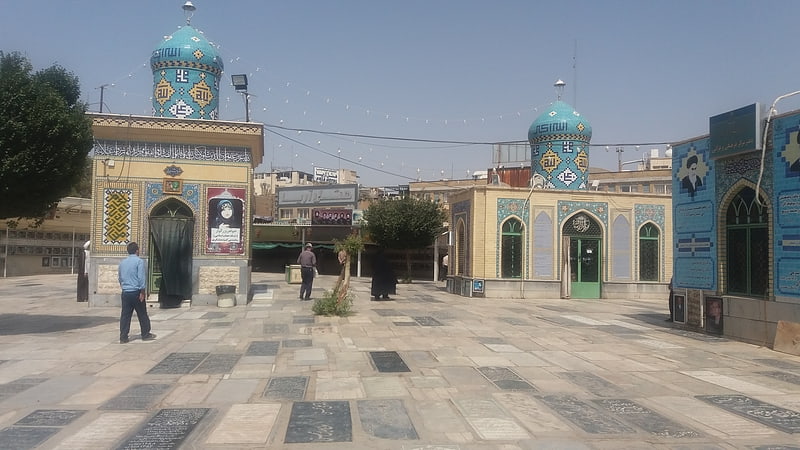
Sheikhan cemetery is the second historical cemetery in the Islamic world and one of the oldest cemeteries in Qom, Qom Province, Iran which is located near the Fatima Masumeh Shrine. The cemetery dates back over a thousand years.
This cemetery is currently the burial place of some Shiite scholars such as Zakaria ibn Idris Ash'ari Qomi, Zakaria ibn Adam Ash'ari Qomi, Mirza-ye Qomi, Mohammad Ali Modarres Khiabani and Mahmoud Ansari Qomi, as well as those killed during the Iranian Revolution (1979) and Iranian soldiers killed during the Iran-Iraq war.
The eight victims of the June 28, 1981 terrorist attack in Tehran, Iran, along with their families, as well as Dr. Mohammad Gharib (father of Pediatrics in Iran) are buried in this cemetery. Also, Mirza Jawad Maleki Tabrizi, the famous Faqīh and Mysticism as well as Fakhr al-Sadat Borghei, one of the victims of the Chain murders of Iran, are buried in this cemetery.[32]
Harireh, Kish Island
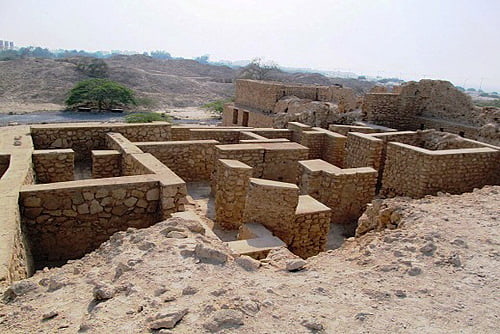
Harireh is an ancient 8th century city located in what is now Kish, Iran. It is situated in the center of the northern coast of the island. Its area is about 3 square kilometers.
Some say Harireh was first built sometime between the late Sasanid period and the early Islamic era. Harireh was quite popular during the Saljuks and Atavakan of Fars. An Iranian cultural heritage organization has verified that Harireh is at least 800 years old.
Harireh is most probably the town that the renowned Iranian poet, Saadi, has referred to in his book Gulistan. There are references in the works of Iranian and Arab historians to the location of the town on the island. These say that the town was situated in the middle of the northern part, precisely where the ruins are standing today.[33]
Ganjali Khan Complex, Kerman
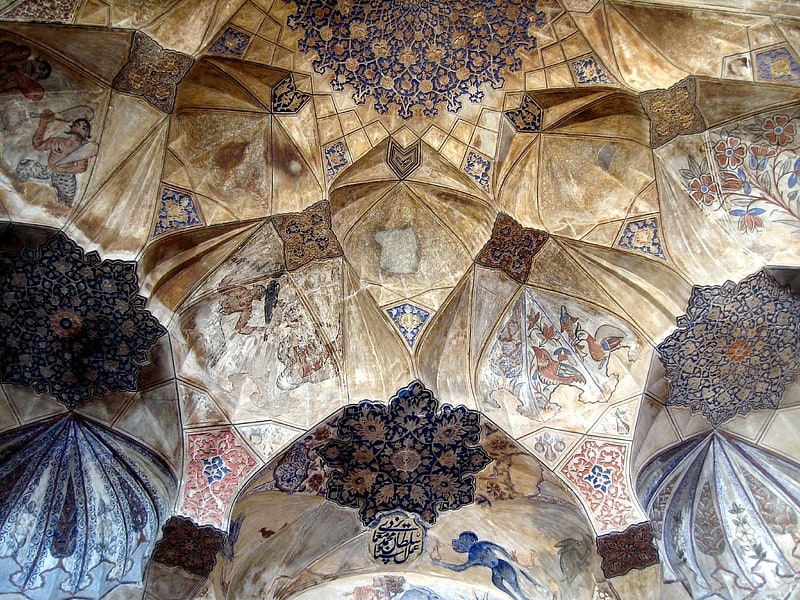
Also known as: مجموعه گنجعلی خان
Tourist attraction in Kerman, Iran. The Ganjali Khan Complex is a Safavid-era building complex, located in the old center of city of Kerman, Iran. The complex is composed of a school, a square, a caravanserai, a bathhouse, an Ab Anbar, a mint, a mosque and a bazaar.[34]
Address: Ganjali Khan Square, Ganjali Khan T-junction, 76134 Kerman
Tomb of Kamal-ol-molk, Nishapur
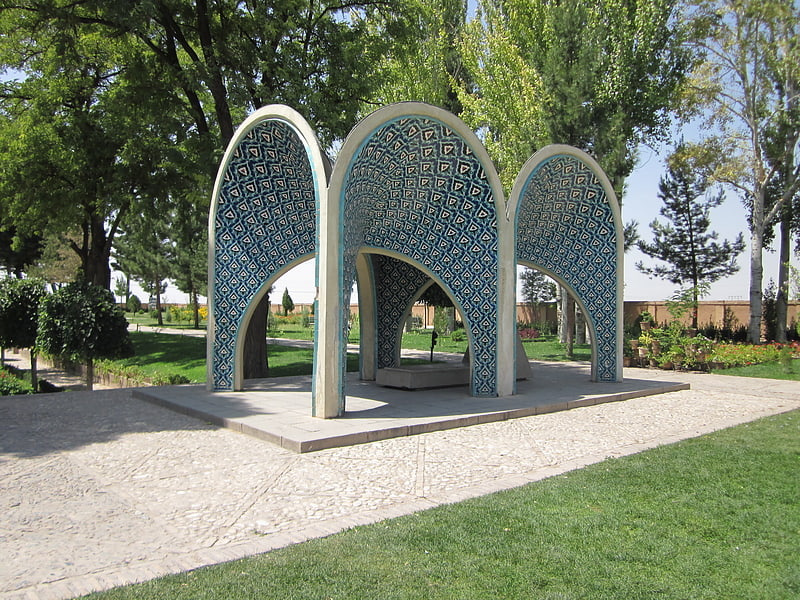
Tomb of Kamal-ol-molk is the tomb of Kamal-ol-molk in Nishapur. This building is located near the Mausoleum of Attar of Nishapur. This tomb was designed by the famous Iranian architect of the time, Hooshang Seyhoun. This memorial was opened in April 1,1963 with the presence of Farah Pahlavi the Shahbanu of the Imperial State of Iran.[35]
Dar ul-Ihsan Mosque, Sanandaj
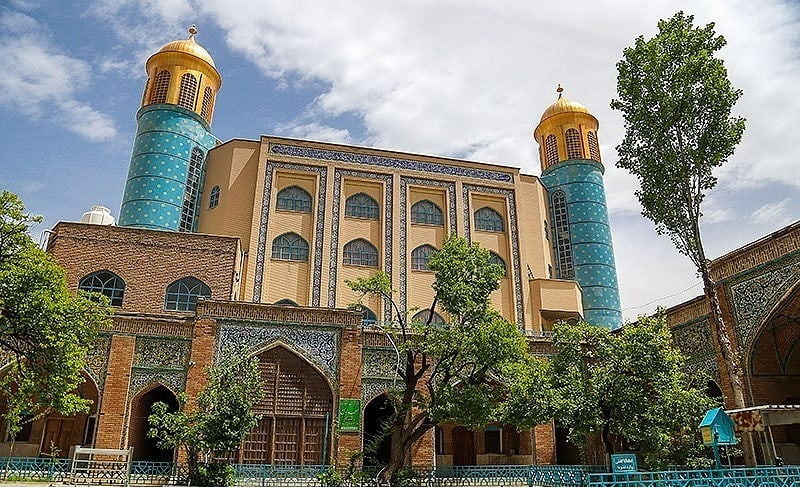
The Dar ul-Ihsan Mosque Or Jameh Mosque of Sananda dates from the Qajar dynasty and is located in Sanandaj.[36]
Emad o dolah Mosque, Kermanshah
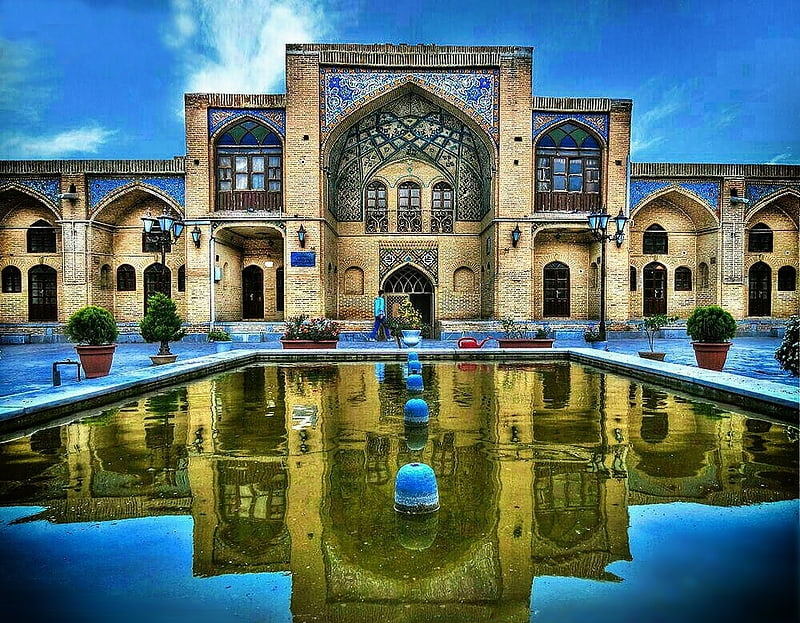
Mosque in Kermanshah, Iran. The Emad o dolah Mosque is related to the Qajar dynasty and is located in Kermanshah. It was built in 1868 by Prince Emam Qoli Mirza, son of Mohammad Ali Mirza and governor of Kermanshah.[37]
Assyrian Pentecostal Church, Kermanshah
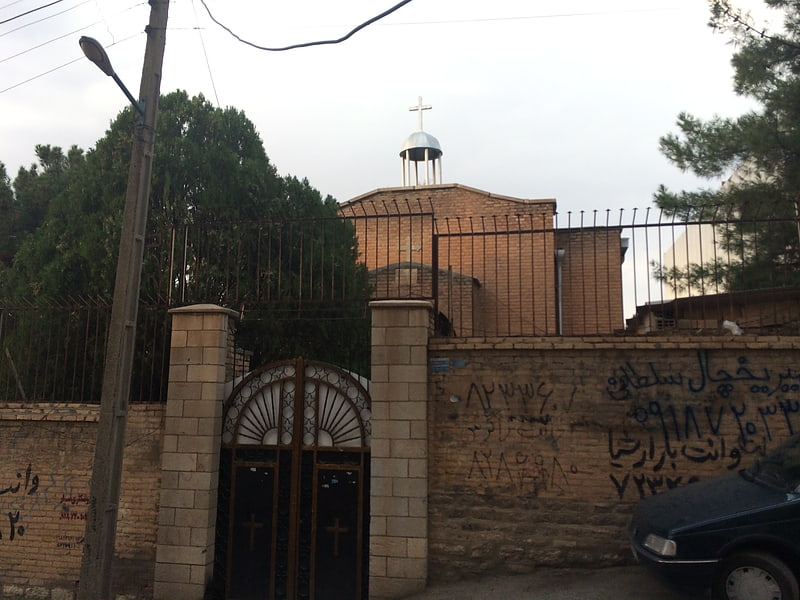
Pentecostal church in kermanshah is an Assyrian Pentecostal Church in Kermanshah city of Iran.[38]
Jameh Mosque of Qazvin, Qazvin
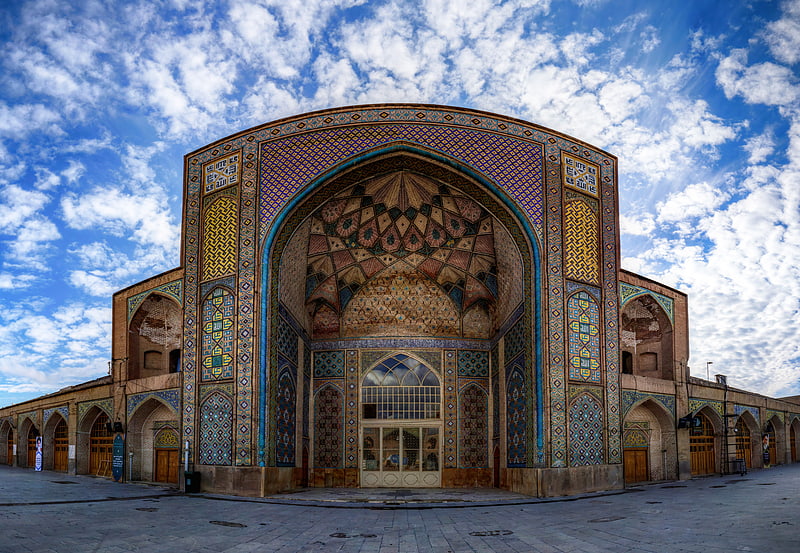
Also known as: مسجد جامع قزوین
Mosque in Qazvin, Iran. Jameh Mosque of Qazvin is one of the oldest mosques in Iran, and is the grand, congregational mosque of Qazvin, in Qazvin Province, Iran.[39]
Sa'd al-Saltaneh Caravanserai, Qazvin

The Sa'd al-Saltaneh Caravanserai is a large Caravanserai located in the city of Qazvin in Qazvin Province of Iran.
Built during the Qajar era, the caravanserai is one of Iran's best preserved urban caravanserais. The builder (patron) of this large caravanserai was a person by the name Sa'd al-Saltaneh Isfahani (آقا باقر سعد السلطنه اصفهاني), after whom the caravanserai is named.
The caravanserai is built on a square plan, has 4 iwans facing a courtyard. The interiors are decorated with Muqarnas and Rasmi bandi.
The Hujrehs, or the rooms for the travelers, are situated one meter above the courtyard ground level. The Hashti behind the southern iwan has the largest gonbad, with 4 semi-domes adjacent to it.
The eastern-western axis of the Hashti is called Dalan-i Qeisariyeh (دالان قيصريه) or "Caesar's Hall", and the north-south axis of the Caravanserai's Hashti is named Dalan-i Ghahremani (دالان قهرماني) or "Ghahremani Hall". The former is connected to the "Bazaar of Vizir" of the city.
There are also two smaller courtyards in the east and west of the Caravanserai.[40]
Shah Abbasi Caravansarai, Nishapur
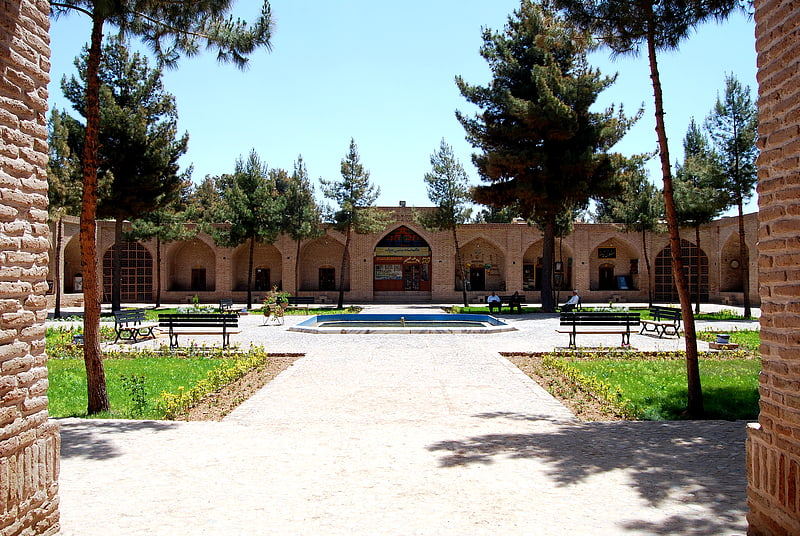
The Shah Abbasi Caravansarai of Nishapur is a historical caravanserai built by the Safavid Empire and is located in the central part of the city of Nishapur. This caravansary was built by the order of the Abbas the Great, the Safavid Shah of Persia. This caravanserai is in the list of the national heritage of Iran. This caravanserai is now used as a tourist attraction and there are also several handicraft shops and two museums inside of it.[41]
Fatima Masumeh Shrine, Qom
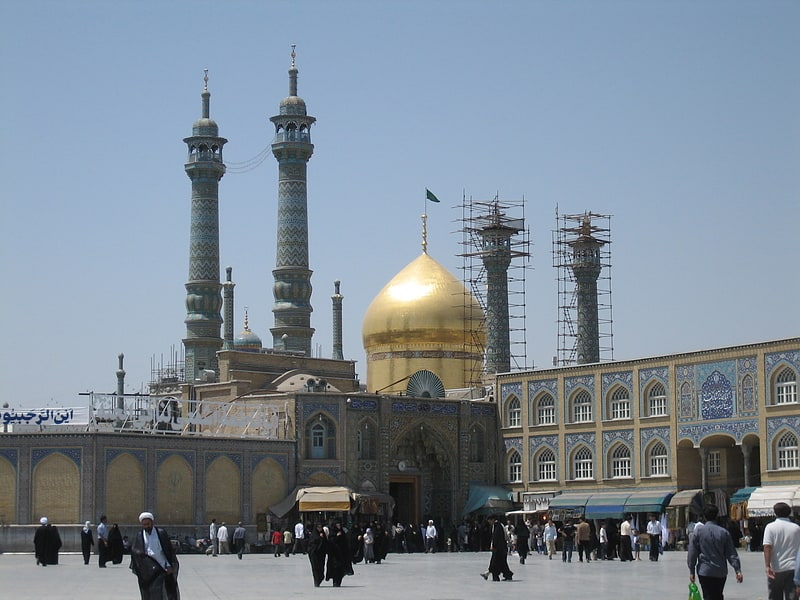
Also known as: حرم فاطمه معصومه
Shrine in Qom, Iran. The Shrine of Fatima Masumeh is located in Qom, which is considered by Shia Muslims to be the second most sacred city in Iran after Mashhad.
Fatima Masumeh was the sister of the eighth Imam Reza and the daughter of the seventh Imam Musa al-Kadhim (Tabari 60). In Shia Islam, women are often revered as saints if they are close relatives to one of the Twelver Imams. Fatima Masumeh is therefore honored as a saint, and her shrine in Qom is considered one of the most significant Shi'i shrines in Iran. Every year, thousands of Shi'i Muslims travel to Qom to honor Fatima Masumeh and ask her for blessings.
Also buried within the shrine are three daughters of the ninth Twelver Shī‘ah Imām Muhammad al-Taqī.[42]
Shorabil Lake, Ardabil
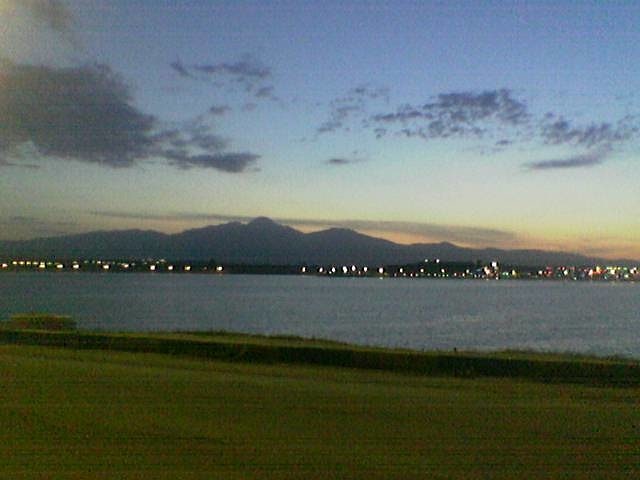
Also known as: دریاچه شورابیل
Lake in Iran. Shorabil Lake is a lake located in a hilly area south of the Iranian city of Ardabil. Ardabil University is located near the lake. The surface of the lake is 640,000 m2, and is covered with a thin white layer of minerals which are useful in healing skin diseases and rheumatism. The leisure complex of Shorabil is located near the lake. The lake is ringed by a scenic roadway offering views of the lake and the nearby Sabalan mountain.
The basin was covered with mud and high concentrations of salt and other minerals so that no fish could survive. In 1998, the government of Ardabil started diluting the lake water by linking rivers from the surrounding area. After almost 2 years they also started growing a kind of fish called "ghezel-aala" in the lake which is famous for having pink meat and wonderful taste. In 1999 a floating restaurant was built and placed in the middle of the lake. which was transferred to the government but it was later shifted to the shore as they could not handle the maintenance and other technical difficulties.[43]
Address: Rah-e-Daneshgah Street, Ardabil
Palace of Ardashir, Firouzabad
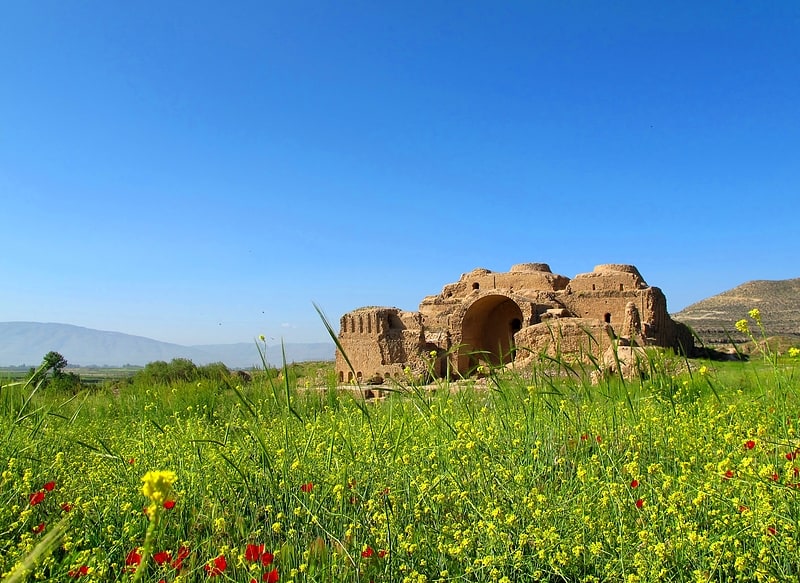
Also known as: کاخ اردشیر بابکان
Palace in Iran. The Palace of Ardashir Pāpakan, also known as the Atash-kadeh آتشکده, is a castle located on the slopes of the mountain on which Dezh Dokhtar is situated. Built in AD 224 by King Ardashir I of the Sassanian Empire, it is located two kilometers north of the ancient city of Gor, i.e. the old city of Artakhsher Khwarah/Khor Adashir/Gor Adesheer in Pars, in ancient Persia. The ancient city where the palace is located, was renamed "Peroz" after Ardashir established the Sassanian Empire by overthrowing Ardavan, the last Parthian king. After the Arabian conquest, Peroz was called Firuz, and the name remained. The modern city of Firuzabad is hence, of important significance in Persian history.[44]
Jameh Mosque of Kashmar, Kashmar
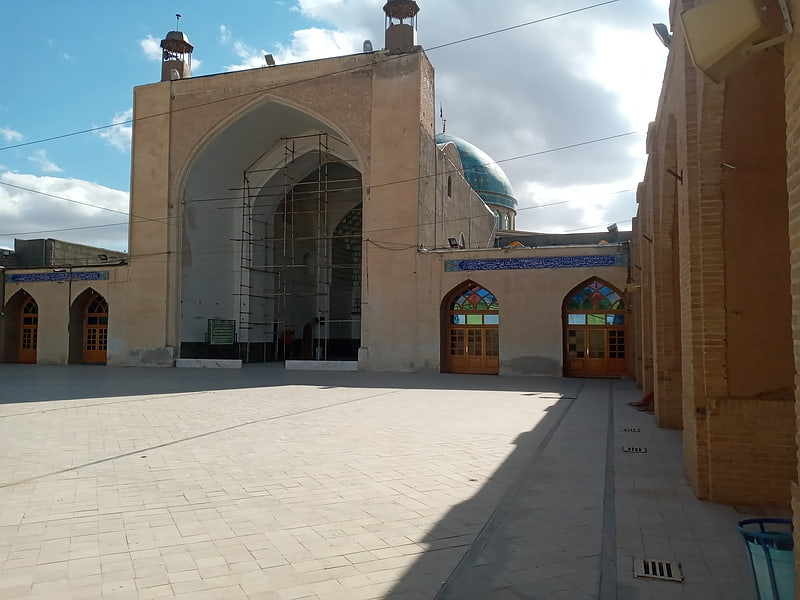
Mosque. Jameh Mosque of Kashmar, the place where Jumu'ah is performed, was built in Kashmar in 1791 by Fath-Ali Shah Qajar. This Mosque is opposite the Amin al-tojar Caravansarai.[45]
Imamzadeh Hamzeh, Kashmar

Imamzadeh Hamzah, Kashmar, the oldest mosque in Kashmar, includes the tomb of Hamza al-Hamza ibn Musa al-Kadhim, the garden and the public cemetery, and is as an Imamzadeh.[46]
Keeyow lake, Khorramabad
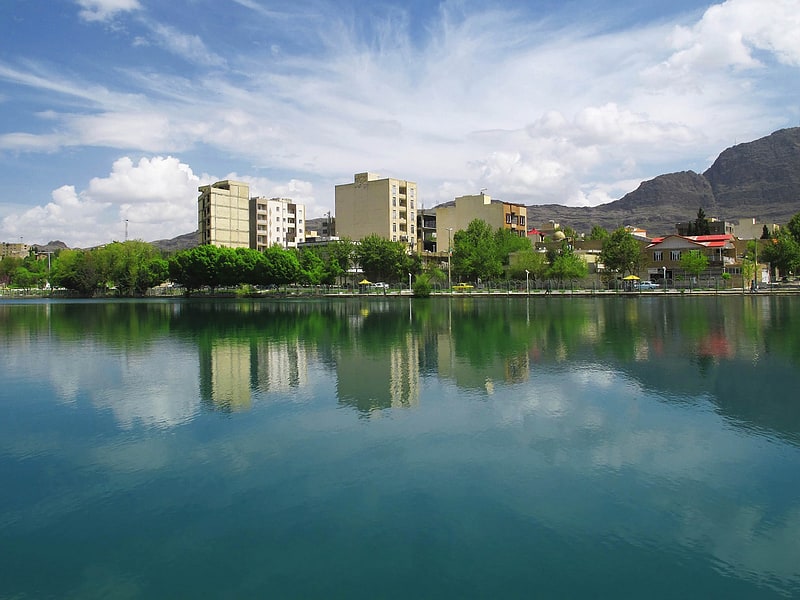
Also known as: دریاچه کیو
Lake in Iran. Keeyow Lake is a natural lake in the northwest of Khorramabad in Lorestan Province, Iran. The lake has a seven-hectare area and a depth of 3 to 7 meters. There is an amusement park as well as other recreational facilities next to the lake. It is the only natural city lake in Iran and is a habitat for native and migratory birds and aquatic animals.[47]
Imamzadeh Seyed Morteza, Kashmar

Imamzadeh Seyed Morteza is related to the Qajar dynasty and is located in Razavi Khorasan Province, Kashmar. Massive trees, waterfalls and swimming pools add to the attractions of this place, and on the other hand, a good number of living rooms provide a good base for traveling to this place, as well as the many shops and dining halls.[48]
Sheikh Safi al-Din Khānegāh and Shrine Ensemble, Ardabil

Also known as: آرامگاه شیخ صفیالدین اردبیلی
Historical place museum in Ardabil, Iran. Sheikh Safi al-Din Khānegāh and Shrine Ensemble is the tomb of Sheikh Safi-ad-din Ardabili located in Ardabil, Iran. In 2010, it was registered on the UNESCO World Heritage List. This monument is situated in the Ali-Ghapu area.[49]
Jameh Mosque of Urmia, Urmia

Mosque in Urmia, Iran. The Jāme Mosque of Urmia also known as, Rezayieh Mosque, is the grand, congregational mosque of Urmia, Iran. The mosque is situated in the older part of the city and was constructed in 13th century during the Ilkhanate era.[50]